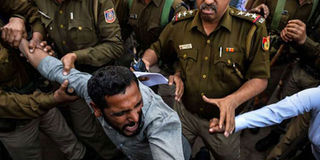Caste war leads to Delhi water woes

An Indian student activist struggles with police officers during a protest in New Delhi on February 24, 2016. Students from different Indian universities are taking part in rallies in the Indian capital following the death of Hyderabad University Dalit scholar, Rohit Vemula, 26, who allegedly committed suicide on January 17, after authorities suspended him and five of his friends over a tiff with a right-wing student political group. PHOTO | AFP
What you need to know:
- Its grievances include the caste-based state jobs and university placement quota system.
To press the point, protesters attacked police and railway stations, sabotaged a canal that provides Delhi with most of its water, and looted.
Why the quota system? It goes back to Vedism, an ancient religion whose text exists.
It names four societal stratums of religious purity: from the highest to the lowest.
For a week India’s capital New Delhi has suffered a water crisis not because of a natural catastrophe but due to a relatively well-off upper caste community seeking state benefits.
The Jat community is predominant in the northern state of Haryana, neighbouring New Delhi.
Its grievances include the caste-based state jobs and university placement quota system. Jat wants it abolished.
To press the point, protesters attacked police and railway stations, sabotaged a canal that provides Delhi with most of its water, and looted.
The government sent in troops with shoot-on-sight orders.
VEDIC CASTE SYSTEM
Why the quota system? It goes back to Vedism, an ancient religion whose text exists. It names four societal stratums of religious purity: from the highest to the lowest.
Those people of India unmentioned in the Vedic writings are impure and, therefore, “untouchable”. So is anything they touch.
How the pure sort out the air they breathe, and air is free for all, beats science.
In modern India, the most known “untouchables” are the Dalit. They are officially classified as: “Other Backward Classes,” “Scheduled Castes,” and “Scheduled Tribes.”
How such derogatory terms are supposed to uplift the self-worthiness of a people disadvantaged for centuries beats logic.
BRITISH RAJ
Contrary to popular opinion, the British Raj didn’t invent the “caste system.” The Raj furthered developments arising from the collapse of the Mughal era.
From 1860 to 1920, the Raj distributed administrative jobs and senior appointments on the basis of existing castes: the higher the caste, the prime the job.
In any society, the higher the income, the more prime the goodies.
Social unrest forced the Raj in 1920 to reserve some state jobs and appointments et al for the “untouchables,” a sort of a quota system.
In essence, the 1947 Indian constitution formalized and refined the Raj system.
Those opposed to it, including the Jat — the Patel were at it last year in Gujarat state — consider it reverse discrimination.
For example, a student with a backward caste certificate needs a lower grade than others to enrol in university.
In real life though what, for example, does a Dalit go through?
In June 2013 one Stalin K of Volunteers of India, a rights group that accumulates reports of misdeed against the Dalit, published a list in Huffington Post: seemingly mundane, barber shops refusing to shave Dalit; homeowners unwilling to rent to them; children discriminated in schools: women chased from wells: segregation in temples, mosques, and churches… ‘‘The list goes on shamelessly,” he wrote.
It should include couples killed for marrying outside castes; a driver run over at a petrol station for refusing to give his place to a higher caste person, ad infinitum of cruelty.
Worse, in February 2015, Shashi Tharoor, an Indian politician, cited a survey showing an average 27 percent of Indians practice caste untouchability.
The Indian constitution is clear: the practice of the banned “untouchability” is “punishable in accordance with law.”
Well, lots of criminals exist on Indian streets. What a compliment to the world’s largest democracy?




